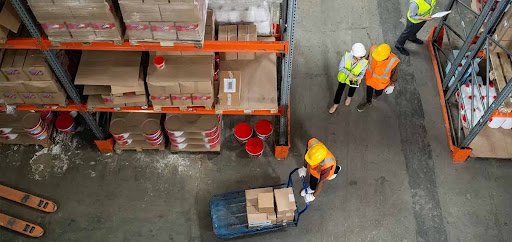Understanding warehouse abbreviation terms is crucial for navigating modern logistics. Whether you’re managing inventory, dealing with suppliers, or working with third-party logistics providers like DelGate, knowing the common warehouse abbreviations will help you stay informed, accurate, and ahead of the curve in 2025.
Why Learn Common Warehouse Abbreviations?
Warehouse operations rely heavily on industry-specific language. Learning common warehouse abbreviations helps reduce errors, improve communication, and optimize daily operations.
Benefits of Knowing Warehouse Abbreviations
From handling inventory to shipping goods, knowing what each abbreviation means ensures everything runs efficiently. This knowledge is especially vital when working with top logistics partners like DelGate, Canada’s leading 3PL provider.
Common Warehouse Abbreviations in 2025
Let’s explore the most used and updated common warehouse abbreviations for 2025. Each of these terms is essential for logistics professionals, warehouse staff, and supply chain managers.
SKU – Stock Keeping Unit
SKU identifies each product and its variations. It helps organize items for quick picking and accurate stock tracking.
ASN – Advanced Shipping Notice
ASN alerts the warehouse about incoming shipments. It includes details like contents, estimated arrival, and packaging specifics.
FIFO – First In, First Out
FIFO is a method of inventory rotation. Products received first are sold or used first to avoid expiry or obsolescence.
LIFO – Last In, First Out
LIFO works the opposite of FIFO. Newer items are dispatched before older ones, often used for non-perishable goods.
3PL – Third-Party Logistics
A 3PL like DelGate offers services such as warehousing, transportation, and order fulfillment to streamline your logistics.
BOL – Bill of Lading
A BOL is a legal document between the shipper and the carrier. It outlines the type, quantity, and destination of goods.
MOQ – Minimum Order Quantity
MOQ is the smallest quantity a supplier will accept for an order. It helps in planning inventory needs and the budget.
WMS – Warehouse Management System
A WMS is software that manages warehouse operations such as tracking inventory, picking orders, and managing shipments.
EDI – Electronic Data Interchange
EDI allows computers to communicate data like invoices and orders between businesses, reducing the need for paper processes.
PO – Purchase Order
A PO is a commercial document issued to a seller. It indicates the types, quantities, and prices for products ordered.
Abbreviations in Shipping and Receiving
Understanding common warehouse abbreviations in shipping and receiving helps improve coordination with carriers and clients.
ETA – Estimated Time of Arrival
ETA helps warehouses prepare for incoming shipments by predicting when items will arrive.
FOB – Free on Board
FOB defines who pays shipping costs and who owns the goods at different transport stages.
DC – Distribution Center
A DC is a warehouse that stores products temporarily before they’re sent to retailers or customers.
TMS – Transportation Management System
A TMS supports the planning and execution of the physical movement of goods.
LTL – Less Than Truckload
LTL refers to shipments that don’t require a full truck, which saves on shipping costs.
Inventory Control Abbreviations
Warehouse staff must master these common warehouse abbreviations to keep stock accurate and avoid over/under-ordering.
JIT – Just In Time
JIT aims to reduce inventory costs by receiving goods only when needed.
MRP – Material Requirements Planning
MRP helps plan inventory, production, and scheduling efficiently.
BOM – Bill of Materials
A BOM lists raw materials and components needed to manufacture a product.
RO – Reorder Point
RO signals when stock should be replenished to prevent running out.
EOQ – Economic Order Quantity
EOQ is the ideal order quantity to minimize inventory and ordering costs.
Safety and Compliance Abbreviations
Safety in warehouses is non-negotiable. These common warehouse abbreviations are key to maintaining compliance.
PPE – Personal Protective Equipment
PPE includes gear like gloves, helmets, and vests to protect warehouse workers.
OSHA – Occupational Safety and Health Administration
OSHA sets safety regulations that warehouses must follow to avoid accidents.
MSDS – Material Safety Data Sheet
MSDS provides safety info about handling, storing, and disposing of hazardous materials.
SDS – Safety Data Sheet
An updated version of MSDS, SDS also helps ensure safe material handling.
How DelGate Uses These Abbreviations in Practice
DelGate, the best 3PL logistics company in Canada, uses these abbreviations every day to run an efficient warehouse. With advanced systems and experienced professionals, it ensures every warehouse abbreviation is applied correctly for the benefit of their clients.
Trends in Warehouse Abbreviations for 2025
More tech integration in logistics means more common warehouse abbreviations are emerging, especially related to automation, AI, and smart tracking systems.
IoT – Internet of Things
IoT devices like sensors and scanners provide real-time data for smarter inventory decisions.
RFID – Radio Frequency Identification
RFID uses electromagnetic fields to identify and track tags on items automatically.
API – Application Programming Interface
API allows different software systems in the warehouse to communicate with each other efficiently.
Tips to Remember Warehouse Abbreviations
- Create flashcards for each warehouse abbreviation.
- Incorporate them in your daily operations.
- Stay updated with industry trends from top logistics providers like DelGate.
Conclusion
In 2025, knowing the common warehouse abbreviations isn’t optional—it’s essential. Whether you’re a warehouse manager, a new employee, or a client of a reliable 3PL like DelGate, understanding these abbreviations enhances communication, reduces errors, and boosts productivity.
FAQs
1. What are warehouse abbreviations?
Warehouse abbreviations are shortened forms of technical terms used in warehousing, logistics, and supply chain operations.
2. Why are common warehouse abbreviations important?
They help save time, improve clarity, and prevent mistakes in daily operations.
3. How can I learn common warehouse abbreviations?
Reading industry resources, taking online courses, and working with experienced 3PLs like DelGate can help.
4. What is the role of DelGate in warehouse management?
It provides expert 3PL services in Canada, handling inventory, shipping, and fulfillment using all the key warehouse abbreviation systems.
5. Are new warehouse abbreviations added every year?
Yes, especially with tech advancements and automation, new abbreviations and terms regularly enter the industry.


